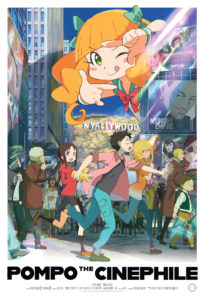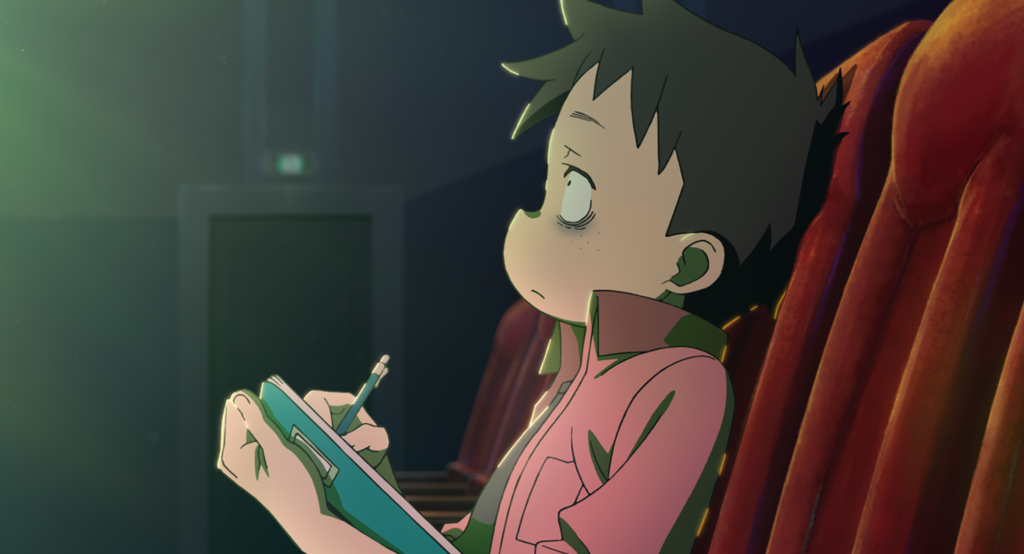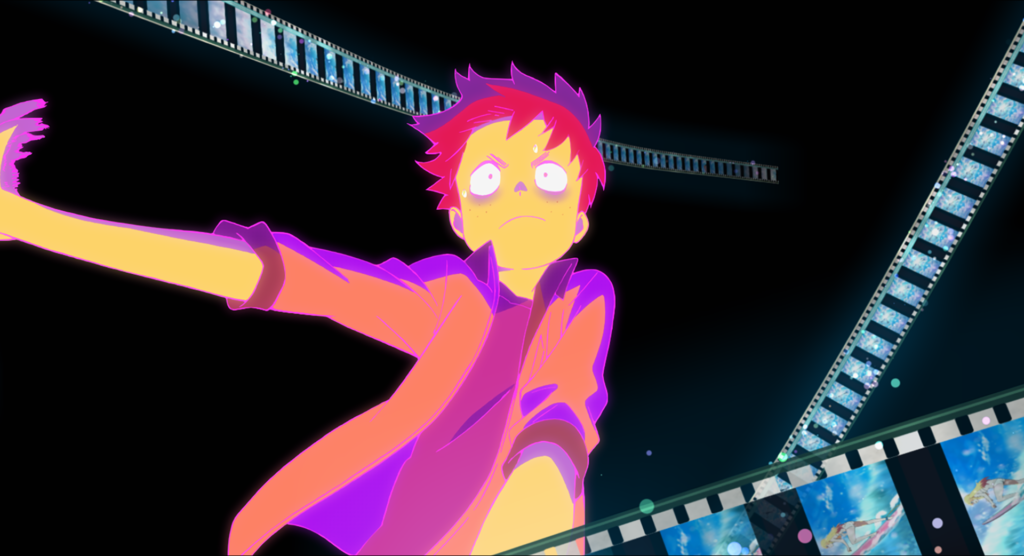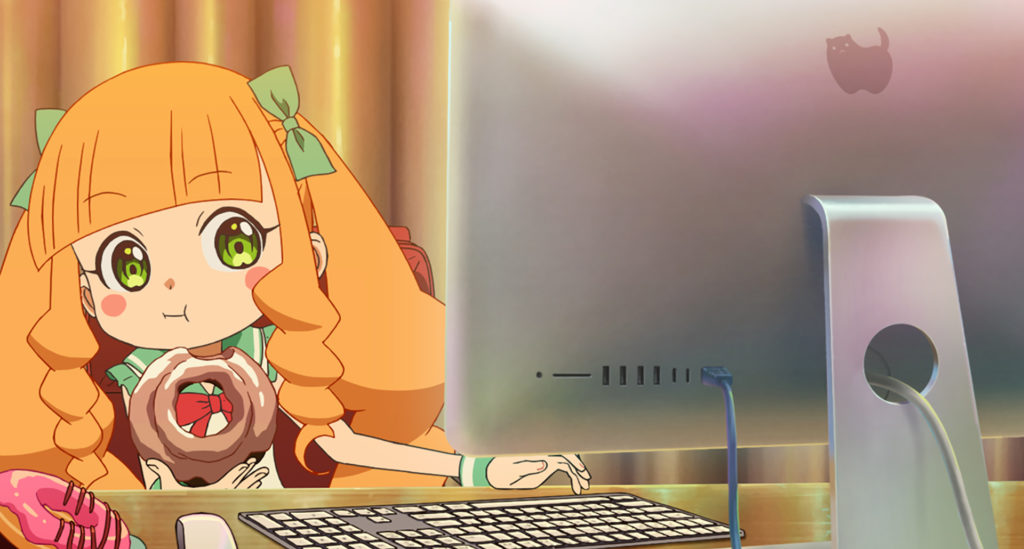A Sugary And Sincere Anime Ode to Filmmaking
DIRECTED BY: TAKAYUKI HIRAO/2021

Films about filmmaking always have to straddle a certain line, making something that isn’t completely bogged down in technical minutiae while still feeling authentic to those familiar with the mechanics of moviemaking. An animated film about the production of a live-action feature is a novel concept, one made with a certain distance from the toolset and timetables, though not the larger language of, live-action cinema. With the greater stylistic scope available only to animated productions, the medium seems the perfect tool for making a sincere and highly distinctive love-letter to the art of making film.
Pompo: The Cinéphile isn’t that love-letter. The latest from director Takayuki Hirao, newly formed animation studio CLAP’s first feature is sincere and distinctive, certainly, but more akin to a love note passed in class. Not quite fully formed, its appreciation raw and emotional, but lacking depth. Despite not quite reaching its potential, suffering from some lacking design work and a somewhat amorphous narrative that struggles to find its footing, Pompo: The Cinéphile is still an earnestly written love note, brimming with exceptional animation, a fun cast of characters, and a very genuine affection for film.

The film follows the eponymous Joelle Davidovich “Pompo” Pomponette, an eternally childlike super-producer in Nyallywood, the semi-fantastical, cat-themed analogue to Hollywood. Pompo – much to the chagrin of her neurotic film-buff personal assistant Gene Fini – is styled in the fashion of the likes of Roger Corman, approaching her work with an eye towards bombastic action, sex appeal, and brief runtimes. Despite this, the perpetually zealous Pompo approaches her work with a sincere, childlike energy, and begins to recognize Gene’s abilities, despite his personality and tastes in film running completely counter to her own. After wrapping on her latest project, Pompo provides Gene with a script for a new feature, Meister, an artistic character drama that seemingly runs counter to Pompo’s own filmmaking ethos, and places him in the director’s chair.
After recovering from the shock of his new role, Gene is assigned his crew, and meets with the film’s leads, the first time actress Nathalie “Lily” Woodward, and renowned “world’s greatest actor” Martin Braddock. Tasked with balancing the needs of the neurotic novice with the at-times aloof veteran during location shooting in the Swiss Alps, Gene is allowed to build his confidence as a director while dealing with the day-to-day of filming, before being thrust into the laborious editing process. As the film’s seeming sole editor, Gene is tasked with assembling his masterpiece, and learning just how much commitment making a film requires.

Pompo: The Cinéphile has a wealth of places to pull conflict and a cogent narrative from, so it’s unfortunate that its idyllic, fantastic view of filmmaking leaves it spinning its wheels. The establishment of its players is protracted and overlong, but it establishes a fun-if-familiar cast of archetypes that seems like it’s leading into a better payoff with the day-to-day tribulations of shooting the film in the Alps. Dealing with a male lead presented to evoke the notoriously difficult to work with Marlin Brando and a female lead demonstrably nervous and unsure of herself from the start of production seems to like it may test Gene’s underdeveloped social skills and force him to grow more while strengthening and better developing the relationship between Pompo’s eclectic cast. However, that isn’t really the case, and the location shooting is mostly a series of charming interludes where occasional hiccups are resolved almost immediately.
Instead, the real conflict of Pompo: The Cinéphile doesn’t really rear its head until the last third. Gene struggling with assembly, finding the film in the edit, is certainly relatable to those who have tried to make a film themselves, but the shift to a conflict centering the need to raise funds to shoot an extra scene is jarring and only serves to undercut the underlying interpersonal and internal conflict that the film always seems just on the verge of exploring. Perhaps, the most frustrating element of this shift in focus is that it seems largely to be in support of the film’s misguided thesis statement.

Art requires suffering. Total commitment to the artform, at the expense of interpersonal relationships. This is a major revelation that Gene is forced to realize as he works towards making his masterpiece. It would be ruinous to the film if its tone weren’t so light and its world so fantastical, and if the film didn’t seemingly undercut this message with the way Gene collaborates with others, Lily by his side as he wraps up his edit. But it’s not meant to be an ironic moral, the film utters it so sincerely, repeating it constantly, and its refutation is never so pointed as to undercut the way it depicts characters like Gene abandoning their health to push forward with their art. It’s a thematic core that the film refuses to wholeheartedly commit to, the argument made conflated by its own content, an issue primarily because it neglects the larger cast at the expense of this moral.
A cast that, combined with the overall light tone and effective visuals, helps compensate for an amorphous, confused narrative. Gene is at times grating, Hiroya Shimizu’s neurotic hybrid exclamations of incredulity-whines, but these instances of vocal characterization become less prevalent as the film goes on, and Gene largely serves as an effective, at times even charming audience surrogate. Martin Braddock, despite possessing the potential to serve as foil for first-time director Gene, is largely an awkward, lonely old man that’s still very effective in front of the camera. Lily is more charmingly neurotic than Gene, a small-town girl who takes on a variety of blue-collar jobs to make it to Nyallywood and become a star. Her narrative is afforded a fair bit of time at the star of the film, but her presence is mostly an afterthought after the crew arrives in the Alps, which is a tremendous waste.

And, of course, the eponymous cinéphile, Pompo. A perpetually youthful ball of energy with an affinity for the crass, an eye of finances, and a sincere love of the medium. Pompo is perhaps the most complex member of the cast, simultaneously a mentor for Gene and a young artist trying to reconcile her tastes with her passion for film; her own idiosyncratic ideas are an effective counterpoint to the more staunchly arthouse Gene. Beyond her strikingly complex inner life, Pompo is a bundle of energy, a forceful performance by Konomi Kohara offering a great deal of positivity without annoying. It may not be her story, but she more than earns her place as the title character, a stand-out character and a wonderful vehicle for some of the film’s best character animation.
This is hardly to claim that the rest of Pompo: The Cinéphile is badly animated. Certainly, the fluid, maximalist animation of Gene literally cutting tendrils of film and reconnecting them will stand out to many viewers as the impressive feat of animation, with its expressive color palette and frenetic energy complimented by a blaring J-rock soundtrack. The scale and elegance on display during the concert scenes as well, multi-layered and carefully choreographed, presented in tandem with the expressive flashbacks rendered with distinctive, childlike linework during the climax similarly stands out. Yet, Pompo is what always jumps to mind when I think of the film’s visuals. Snappy movement that tends to smear between poses, layouts exaggerate her proportions in something approaching Kanada-style animation, with a great deal of attention paid to her distinctive double-drill haircut.

Pompo may also stand out from those other instances of effective animation because of the quality of her design. Certainly, as a mascot character of sorts, hers is the most refined, but it does sort of leave the rest of the fairly plain cast feeling rather drab by comparison. Compounding this is the way that the core cast of characters, particularly Lily, Pompo, and Gene, are intended to be young adults but look like children compared to the adults around them. In the case of Pompo it suits her character, but with the other two it seems a bit odd. More than anything, the designs just aren’t quite as well suited to animation, Gene especially, which dulls the aforementioned sequences of him slicing film. A minor issue, certainly, but worth noting.
Overall, despite my criticism of Pompo: The Cinéphile’s narrative and thematic messaging, there’s still a strong core and a lot of heart imbued into its production. Its charming cast and enjoyably kinetic animation keep you invested in the proceedings, and its simplistic, wish-fulfillment fantasy of filmmaking is just grounded enough to not completely alienate those familiar with the mechanics of making movies. Not anything so complex as a love-letter, but earnest and assembled with enough competence to entertain anime and film enthusiasts alike.

